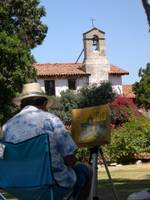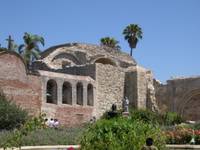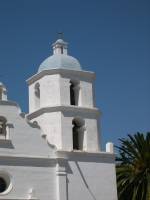Myths of Alta California
Crossposted to Cliopatria.I spent several days in California visiting my parents. They no longer live in Los Angeles, moving to one of the interior valleys about a decade ago. This was the first time I had been in California and did not visit LA–--it was no longer my home. And as Goa Xingjian says, it is impossible in a city for any place to belong exclusively to one person. Still, I was a tourist in the place of my birth.

The Temecula Valley, where they live now, has undergone immense change in a short time. It is high desert nestled between tall mountains. The climate is generally dry, and trees are precious. Initially, there were numerous orange groves; to the south there are avocado groves. There is also a small wine country with a dozen and a half vineyards. Every time I visit I am impressed by the progress made by the winemakers
The landscape is a piece of the Mexican desert pushing into California. In fact, there are a number of strong, long-standing Mexican-American communities. It is possible to see a long distance from almost anywhere within the valley. My Connecticut-born wife thinks it is picturesque, but not quite hospitable.
This area has come under pressure as new housing developments are raised and new people move in. A few orange groves have disappeared. Cookie-cutter houses obscure the original buildings that were appropriately weathered. The new residents commute to far off San Diego and Orange Country ... and to LA in some cases. They don’t understand the Mexican Americans who live in the area.
Being a tourist at home allowed me to do tourist things that I would not have done before. One thing I wanted to do was explore Spanish Colonial influence. Local myth in New England is intimately entwined with the founding history of America: people tend to see all American history originating from them. I was happy to show my wife the history and myths of old California with which I was raised.

The myth, of course, is that of Catholic missions and Father Junipero Serra: a Franciscan who was sent to establish a firm Spanish presence in Alta California against the encroachment of British and Russian traders and to Catholicize the natives. The mission were outposts whereat Europeans and natives coexisted. They were the basis for the settlement of California. The pastoral image of monks and natives living together in harmony persists today. The reality was that the mission system, while growing, was fragile, and the religious goals of the missionaries conflicted with the goals of the crown, which wanted to turn natives into Spanish citizens. To this end, the state founded towns: there were parallel policies that led to the settlement (in the European sense) of California.
We drove out to two missions, San Juan Capistrano and San Luis Rey (a beautiful drive over the mountains). Each mission left me with a different impression. San Juan Capistrano completely fit its romantic image. The mission is right in the middle of the city, surrounded by streets that run parallel to the walls. Large parts of the structure have been not been rebuilt, giving that classic look of a ruin. The large church has been left completely open to the elements, its roof having collapsed in an earthquake. The gardens are filled with colorful plants; there are running fountains. Numerous artists paint the famed bells. Parts of the mission dedicated to artisanship are open and thoroughly explained. There is even a little display showing the piano whereat “When the swallows return to Capistrano” was composed. So close to the street, the mission is more of a park than an historical site–a respite from urban life among romantic surroundings.
San Luis Rey has been restored. The damage that it experienced has been repaired, and it appears to be more functional. The mission is painted in a stark white, and stunning site as it is some distance from its city. One of the last missions that was built, it was meant to look more like a baroque Spanish church. Details that would normally have been created with wood carving, stained glass and marbled stone were painted in. Imported statues of religious figures were evocative and emotional. The museum was well organized, showing the articles of daily and religious life. Most of these came from Spain, although some were produced in Mexico and (in rare cases) locally.


Despite its restoration, San Luis Rey probably did more to recreate the impression of a mission against the Southern California landscape: a stark white edifice against high mountains, surrounded by land affected by drought. I was transfixed by two photographs that showed the conditions of both mission in the mid-nineteenth century. Not only were they in need of repair, but the landscape was desolate. Time has given richer flora to both San Juan Capistrano and San Luis Rey (thanks to the likes of William Mulholland). However, the former looks like a piece of paradise in a hectic world. The former reveals more of the imposing presence of the Church when it was first built, something that could have been alien and unfamiliar. Furthermore, San Juan Capistrano gave the impression that the missions were self-sufficient because of the centrality of displays of artisanship, a notion betrayed by San Luis Rey.







0 Comments:
Post a Comment
<< Home